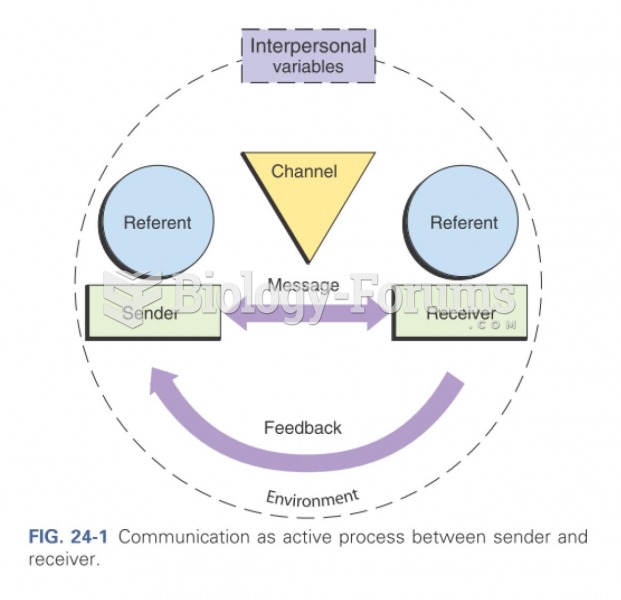Answer to Question 1
The tips for working with individuals with disabilities were given in Table 9.11 on page 239.
Tips for working with individuals using a wheel chair including the following:
- Don't push, touch, or lean on the person's wheelchair.
- Consider physical obstacles (curbs, stairs, hills) when giving directions.
- Keep halls, corridors, and aisles clear.
- Ask before you help.
- Offer to shake hands, usually possible for those with limited hand use or artificial limb.
- Don't make assumptions.
- Keep floors dry and slip free. Use rubber mats to prevent falls.
- Position yourself at eye level when talking with a person in a wheelchair.
- Position computers, telephones, and equipment within a wheelchair user's reach.
Tips for working with individuals who are deaf including the following:
- If appropriate, use a qualified sign-language interpreter for complex exchanges of information, such as a job interview.
- Speak directly to the person who is deaf, not the interpreter.
- Look directly at the person when speaking. Use simple, easy-to-understand sentences.
- Avoid smoking, chewing gum, or obscuring your mouth.
- Speak clearly. Some people who are hard of hearing watch people's lips as they speak.
- Use meaningful facial expressions and gestures.
- Gain the person's attention before speaking. Gently wave your hand or tap the person on the shoulder or arm.
- Rephrase, rather than repeat, words, phrases, or sentences the person doesn't understand.
- People who are deaf or hard of hearing make and receive telephone calls with a TTY (a teletypewriter). If you don't have a TTY, dial 711 to reach the national telecommunications relay service. They can facilitate a telephone call between you and an individual who uses a TTY.
- When working in a group, ask people who are deaf or hard of hearing how they prefer to communicate (sign-language interpreter, read lips, write back and forth, and so forth).
Tips for working with individuals who are blind including the following:
- Identify yourself and others with you.
- Never touch a person's cane or guide dog.
- When walking alongside someone with a visual impairment, note obstacles, such as stairs, revolving doors, hanging plants, and so forth.
- Describe the location of objects. (There is a desk four feet in front of you at two o'clock.)
- Excuse yourself before leaving a person who is blind. Leave him near a desk, chair, or other landmark.
- Offer to read written information, such as menus, instructions, or agreements.
- Provide magnification devices or writing guides for computer screens.
- Use accessibility guidelines when designing your website.
- Consider speech-recognition software, smartphones, and low-vision, adaptive devices for people with visual impairments.
Tips for working with individuals who have speech difficulties including the following:
- Don't assume a person with a speech disability has a cognitive impairment.
- Try to find a quiet environment in which to communicate.
- Give the person your complete attention. Never interrupt or pretend to understand when you do not.
- Be patient. Never finish a person's sentences for him.
- When possible, ask questions that require short answers.
- Repeat for verification if you are not sure you understand.
- If repeated attempts to understand the person fail, find another method to communicate. For example, ask him to write down what he is saying.
- If you have difficulty understanding someone on the telephone, use a speech-to-speech relay service.
- If a person uses a communication device, make sure it is within easy reach.
- If a person uses an interpreter or attendant, look directly at the person who is speaking, not the attendant.
Tips for working with individuals who have hidden disabilities including the following:
- Realize physical appearances can be deceiving. It is possible to look good but still have a serious illness.
- Understand pain and fatigue, common symptoms with invisible disabilities, may limit a person's ability to walk, sit, or stand for long periods.
- Recognize people with hidden disabilities may manage their condition through medication and self-management (limiting stress, alternating demanding activities with periods of rest, self-pacing). Good self-management may prevent disease progression.
- Understand that simple tasks, such as shaking hands, pouring coffee, and walking up and down steps, may be painful for a person with an invisible disability. Be sensitive and respond positively to requests for help.
- Work with the individual to modify tasks. She is an expert in what works and what doesn't.
- Recognize physical symptoms and limitations may change based on fluctuations in the disease process.
- Understand changes in medication often result in changes in health.
- Understand someone with a hidden disability may be physically unable to participate in social activities and events, such as dancing, golfing, or other activities.
- Know that people with invisible disabilities often require more rest, which makes late nights difficult.
- Know that people with invisible disabilities may require special accommodations under the Americans With Disabilities Act, such as limited travel, flexible work hours, workstation modification or placement, or telecommuting. Contrary to popular opinion, most accommodations are not expensive.
Answer to Question 2
b







